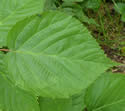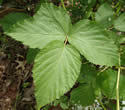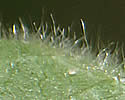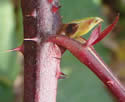Rubus rosa (Rose Blackberry)
| Also known as: | |
|---|---|
| Genus: | Rubus |
| Family: | Rosaceae (Rose) |
| Life cycle: | perennial woody |
| Origin: | native |
| Habitat: | part shade, shade, sun; average to dry sandy soil; hardwood or mixed forest, woodland edges, roadsides |
| Bloom season: | May - June |
| Plant height: | 4 to 8 feet |
| Wetland Indicator Status: | GP: UPL MW: FACU NCNE: FACU |
| MN county distribution (click map to enlarge): |  |
| National distribution (click map to enlarge): |  |
Pick an image for a larger view. See the glossary for icon descriptions.
Detailed Information
Flower: 



![[photo of raceme flower cluster]](/udata/r9ndp23q/trees/rubus-rosa_0616_114405-t.jpg) Flower clusters at the tips of short lateral shoots along 1-year-old stems, each cluster with 5 to 24 flowers. The cluster can be in one of two forms: a relatively wide raceme with flower stalks more or less perpendicular to the stem, or a more branching, flattish/convex cluster at the tip with smaller clusters on long stalks arising from leaf axils, known as a compound corymb. Flowers are white, 1 3/8 to 2 inches (3.5 to 5 cm) across with 5 rounded petals. In the center is a green cluster of many styles surrounded by a ring of numerous, creamy white-tipped stamens.
Flower clusters at the tips of short lateral shoots along 1-year-old stems, each cluster with 5 to 24 flowers. The cluster can be in one of two forms: a relatively wide raceme with flower stalks more or less perpendicular to the stem, or a more branching, flattish/convex cluster at the tip with smaller clusters on long stalks arising from leaf axils, known as a compound corymb. Flowers are white, 1 3/8 to 2 inches (3.5 to 5 cm) across with 5 rounded petals. In the center is a green cluster of many styles surrounded by a ring of numerous, creamy white-tipped stamens.
![[close-up of sepals and flower stalk]](/udata/r9ndp23q/trees/rubus-rosa_0616_134459-t.jpg) Cupping the flower are 5 green sepals, generally triangular, the tip long tapering or abruptly narrowed with a tail-like extension, the outer surface moderately to densely covered in a mix of glandular and non-glandular hairs. Flower stalks are similarly hairy, and also have a few prickles.
Cupping the flower are 5 green sepals, generally triangular, the tip long tapering or abruptly narrowed with a tail-like extension, the outer surface moderately to densely covered in a mix of glandular and non-glandular hairs. Flower stalks are similarly hairy, and also have a few prickles.
Leaves and stems: 

![[leaf scan]](/udata/r9ndp23q/trees/rubus-rosa_0823_10555761-t.jpg) Leaves are alternate and palmately compound, the non-flowering first-year stems (primocanes) with 5 leaflets or sometimes 3 on the lower stem, the flowering second-year stems (floricanes) with mostly 3 leaflets. Leaflets are sharply toothed around the edges, softly hairy on the upper surface, velvety hairy on the lower. The terminal leaflet on primocanes is 3¾ to ~6¾ inches (9.5 to 17 cm) long, to 5+ inches (8.5 to 13 cm) wide, broadly egg-shaped to nearly round, at least ¾ as wide as long, rounded to heart-shaped at the base, tapering to a pointed tip.
Leaves are alternate and palmately compound, the non-flowering first-year stems (primocanes) with 5 leaflets or sometimes 3 on the lower stem, the flowering second-year stems (floricanes) with mostly 3 leaflets. Leaflets are sharply toothed around the edges, softly hairy on the upper surface, velvety hairy on the lower. The terminal leaflet on primocanes is 3¾ to ~6¾ inches (9.5 to 17 cm) long, to 5+ inches (8.5 to 13 cm) wide, broadly egg-shaped to nearly round, at least ¾ as wide as long, rounded to heart-shaped at the base, tapering to a pointed tip.
![[close-up of leaf stalk]](/udata/r9ndp23q/trees/rubus-rosa_0616_115744-t.jpg) Leaflet stalks are densely covered in a mix of glandular and non-glandular hairs, and scattered broad-based, straight or curved prickles. At the base of the compound leaf stalk is a pair of appendages (stipules), lance-linear, ½ to ~¾ inch (12 to 20 mm) long.
Leaflet stalks are densely covered in a mix of glandular and non-glandular hairs, and scattered broad-based, straight or curved prickles. At the base of the compound leaf stalk is a pair of appendages (stipules), lance-linear, ½ to ~¾ inch (12 to 20 mm) long.
![[photo of stem prickles and glandular hairs]](/udata/r9ndp23q/trees/rubus-rosa_0616_115729-t.jpg) Prickles are up to about 1/3 inch (6 to 8 mm) long, broad-based, straight to slightly curved, very sharp, and moderately abundant but unevenly spaced along the stem. The upper stem is also sparsely to densely covered in glandular hairs, though these can wear away as the season progresses. Stems are up to 8 feet (to 2.5 m) long, green to dark red or purple, initially erect, becoming leaning or arching, but the tip not usually reaching the ground so not rooting at the tips, and die the second year after fruit matures. Colonies may form from spreading rhizomes.
Prickles are up to about 1/3 inch (6 to 8 mm) long, broad-based, straight to slightly curved, very sharp, and moderately abundant but unevenly spaced along the stem. The upper stem is also sparsely to densely covered in glandular hairs, though these can wear away as the season progresses. Stems are up to 8 feet (to 2.5 m) long, green to dark red or purple, initially erect, becoming leaning or arching, but the tip not usually reaching the ground so not rooting at the tips, and die the second year after fruit matures. Colonies may form from spreading rhizomes.
Fruit: 
![[photo of developing fruit]](/udata/r9ndp23q/trees/rubus-rosa_0630_112519-t.jpg) Fruit is a round to cylindric cluster of fleshy drupelets, up to about 2/3 inch (8 to 16 mm) diameter, maturing from green to red to black, and are quite tasty.
Fruit is a round to cylindric cluster of fleshy drupelets, up to about 2/3 inch (8 to 16 mm) diameter, maturing from green to red to black, and are quite tasty.
Notes:
Rose Blackberry is an occasional species primarily in the north-central counties of Minnesota, where it reaches the northwestern tip of its range, with scattered populations around the Twin Cities and into our southeastern counties. Like many other blackberries, it has a preference for the part shade of woodland edges but has also been found on open, grassy slopes and creek banks. The preference is for dry, sandy soil but it tolerates loam and moister conditions. It is rumored this is the species from which horticultural varieties were developed for their fruit.
Rubus is a large and difficult genus; both first year (non-flowering primocane) and second year (flowering/fruiting floricane) stems from the same plant may be necessary for a positive ID. Multiple species frequently grow together so stems from the same plant is recommended. Primocanes should be used for stem and leaf characteristics, floricanes mostly for just flowers and fruit. Characteristics to look for are the size and shape of the flower cluster as well as the flower, whether there are glandular and/or non-glandular hairs (on sepals, leaves, stalks and/or stems), whether there are any broad-based prickles or needle-like bristles, number of leaflets on the primocane and whether they are palmately or pinnately compound, whether canes are low-growing or trailing along the ground and/or root at the tip. In some species, the leaflet shape may also be relevant. Floricane leaves are frequently different from primocane leaves in shape and/or number of leaflets so are not a good substitute, and keep in mind that primocanes mature and tip-rooting occurs later in the season than peak flowering time.
Rose Blackberry is identified by the combination of: abundant glandular hairs on sepals, flower stalks, leaf stalks and the upper portion of stems; prickles are broad-based, straight to slightly curved, 6 to 8 mm long; lower leaf surface is velvety hairy; the flower cluster is either a raceme or compound corymb with up to 25 flowers. Canes can reach 8 feet in length and typically lean or arch over but are not known to root at the tips. Primocane leaves mostly have 5 leaflets, sometimes 3 on the lower stem, the terminal leaflet is notably broad, has a short extended tip (acuminate) and is rounded to heart-shaped at the base.
In many references Rubus rosa is lumped in with R. allegheniensis, along with R. alumnus, but we follow the treatments by Mark Widrlechner and documented by Welby Smith in his book “Trees and Shrubs of Minnesota”, which keeps them split as separate species. All have velvety leaves, broad-based prickles and a mix of glandular and non-glandular hairs. R. ithacanus also has these traits but is low-growing, the canes trailing along the ground and rooting at the tips.
R. rosa is most easily recognized by the large, broad terminal leaflet, at least ¾ as wide as long, but its flowers and fruits tend to be larger than others as well. The compound corymb flower cluster is another distinction, though, per Welby Smith's book, this has only been seen in the north-central part of the state and not elsewhere (our photos of that came from Pine County). The terminal leaflet on both R. alumnus and R. allegheniensis is more narrowly egg-shaped or elliptic, about half to 2/3 as wide as long, and the raceme on R. allegheniensis is a narrow, elongated raceme.
Native Plant Nurseries, Restoration and Landscaping Services ↓
More photos
 primocane in early August
primocane in early August flowering in mid June
flowering in mid June canes are erect, leaning or arching
canes are erect, leaning or arching Rubus rosa on a sandy slope
Rubus rosa on a sandy slope largest terminal leaflets are nearly round
largest terminal leaflets are nearly round lower leaves on primocanes sometimes have only 3 leaflets
lower leaves on primocanes sometimes have only 3 leaflets leaves are soft and velvety hairy
leaves are soft and velvety hairy stipules are lance-linear, stems turn dark red
stipules are lance-linear, stems turn dark red a compound corymb flower cluster
a compound corymb flower cluster fruit in mid August, in a droughty year
fruit in mid August, in a droughty year flowers are up to 2 inches (3.5 to 5 cm) diameter
flowers are up to 2 inches (3.5 to 5 cm) diameter
Photos by K. Chayka taken in Aitkin, Clearwater and Pine counties. Photos by Peter M. Dziuk taken in Fillmore and Pine counties.
Comments
Have you seen this plant in Minnesota, or have any other comments about it?






